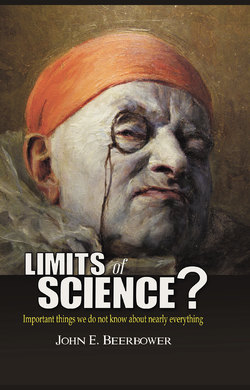Читать книгу Limits of Science? - John E. Beerbower - Страница 36
На сайте Литреса книга снята с продажи.
The Nature of Mathematics
ОглавлениеMathematics is encountered everywhere in today’s world. Its usefulness (even, indispensability) as a tool in applications from almost all fields is beyond dispute. The big question that I address here is: why is it that mathematics is so useful? Or, in other words, what is the relationship between mathematics and the physical world? The question is a methodological one, similar to the types of issues that have already been introduced.
I do not think that the deeper philosophical questions about the foundations of mathematics need generally concern us, such as whether mathematics reflects something that is in some sense real or is only a creation of the mind; whether mathematics should be limited to concepts that have physical analogs; whether mathematics is the study of logic or structure or something else or whether all of mathematics can be captured in a single comprehensive and consistent structure (such as set theory). See, e.g., “Philosophy of Mathematics” (revised 2 May 2012), Stanford Encyclopedia of Philosophy; Ian Hacking, Why Is There Philosophy of Mathematics at All? (2014); Mark Colyvan, An Introduction to the Philosophy of Mathematics (2012).
Perhaps, the more accurate assertion is that the issues to be explored here do not require us to take a position on a comprehensive philosophy of mathematics or on many of the issues that have been the subject of debate among those who have attempted to formulate or critique philosophies of mathematics. However, the discussion will suggest that some of the dilemmas encountered may be the result of attempting to fit fundamentally different things into a single category.
I do think it useful, therefore, to state explicitly that the term mathematics refers to a rather wide range of intellectual methods and activities that can look quite different and can serve very different methodological functions in science. Think of just the basic academic subjects: arithmetic, geometry, algebra, trigonometry, and calculus. Many of the symbols used are different, the types of statements presented look different and the uses of the various disciplines are different; yet, one recognizes intuitively that there is something fundamentally similar among all of these activities.
Arithmetic and geometry are recognized as highly useful tools for dealing with the world around us, whether in our daily errands, our work or our play. Indeed, many of the applications of the more elementary branches of mathematics as a tool seem almost second nature. Counting, adding, subtracting, multiplying are functions that tie directly to our actual experience of the things of the external world. Geometry also appears to be an idealized conceptualization of relationships that exist and can be observed in the physical world, such as the volume of a cube or the area of a circle. So, we could say that these branches of mathematics may have been initially developed in order to represent the relationships that existed.1
Yet, science makes use of many forms of mathematics and does so in many different ways.
Statistical analyses and related quantitative methods are used to organize data and to extract information from it, such as correlations between or among variables reflected in the data. This branch of mathematics, including probability theory, has found wide application in biology and the social sciences, as well as in astronomy and other natural sciences. Morris Kline, Mathematics for the Nonmathematician (1967), p.499 (hereinafter “Mathematics”).
In addition, there has been considerable use of “game theory” models in economics and in evolutionary biology. See, e.g., Martin A. Nowak (with Roger Highfield), SuperCooperators (2011). Many modern sciences make use of large simulations in which values for certain variables are placed into sets of equations and operations are performed hundreds, thousands or millions of times by computer.
A particularly intriguing use of mathematical simulations is to perform hypothetical tests for potential causality. The idea is to make discreet changes in specific assumptions, run the model and then see how the resulting scenario compares to our observations of the existing world. If the constructed results resemble what has in fact happened, one has some support for the validity of the new assumption. See, e.g., Jonathan Webb, “Evolution ‘favours bigger sea creatures,’” BBC News, Science & Environment, 19 February 2015 (a study of marine fossils suggests that marine life have in general gotten large since the Cambrian period; the question asked was whether the larger body size could have been the result of evolution in which larger size had adaptational value; in some of the computer simulations, the researchers gave larger size a beneficial effect; when the program with that adjustment was run, the tendency was for the marine life to get larger as appears to have happened).2
The point here is simply that examples of the mathematics in these various uses, if set forth on the page, would look very different one from another, both in form and function.
